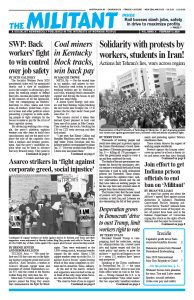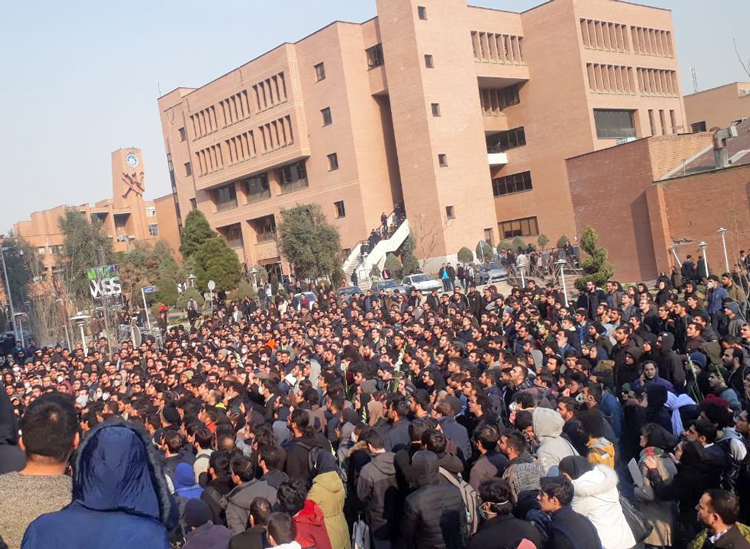Thousands of working people and youth have taken part in protests against the Iranian Revolutionary Guard shooting down a Ukrainian passenger aircraft Jan. 8 — killing all 176 passengers — after the government sought to cover it up and then confessed the truth.
The depth of the anti-government sentiment has forced the reactionary clerical regime to withhold the kind of brutal repression it used to quell widespread protests last November. Those actions also targeted the capitalist rulers’ military interventions abroad and the toll they have taken on working people. So far the cops have only arrested some 30 people from these demonstrations.
The Iranian rulers fear the new round of protests will grow. Similar demonstrations in both Iraq and Lebanon are also demanding the fall of their governments and protesting against Tehran’s interference there.
These actions deserve the support of working people worldwide.
Protests against the Iranian rulers’ cover-up spread to at least a dozen cities and towns over four days through Jan. 14. When the mother of one of those killed in the plane went to collect her child’s body, she insisted the Iranian national flag be taken off the coffin, outraged at the government’s lies.
Protesters across the country have made a point of leaving their faces uncovered, ready to stand up and be counted. Prominent performers, athletes and a number of opposition politicians in parliament have condemned the officials’ deceit, saying it robbed the government of any moral standing.
Students at Amir Kabir University in Tehran, where protests began, issued a statement Jan. 19 condemning “the ruling order” whose “sole response to every crisis is repression.”
Supreme Leader Ayatollah Ali Khamenei responded by trying to shore up support for the regime, calling for “national unity,” praising the Revolutionary Guard and claiming the Quds Force, which spearheads the rulers’ military interventions abroad, was simply “a humanitarian organization.”
The Iranian rulers have recruited and organized militias to fight alongside the Quds Force and extend the counterrevolutionary regime’s reach in Iraq, Syria, Lebanon, Yemen and elsewhere. These units turned the tide of Syria’s civil war in favor of the dictatorial Bashar al-Assad regime; dealt blows to the Iraqi Kurds’ struggle for national rights; and are unleashing murderous assaults on anti-government protests in predominantly Shiite southern Iraq today.
Under the banner of defending Shiite Islam, Tehran’s military interventions are aimed at expanding its sway and dealing blows to rival capitalist powers in the region. These extend abroad the counterrevolution carried out at home in the 1980s to push back gains by working people during the 1979 Iranian Revolution.
That uprising was not a religious jihad, as it is painted by both the U.S. rulers and Tehran, but a struggle of millions who fought tenaciously to oust the U.S.-backed shah, setting up workers councils in the factories and fields as they fought to advance their interests.
The new bourgeois government successfully pushed working people back and stabilized their rule, but were never able to crush the working class.
Protests continue in Iraq, Lebanon
Tehran has worked relentlessly to expand its influence over the government in Iraq — the only predominantly Arab country with a Shiite majority — organizing tens of thousands into Iranian-led militias there.
Since October hundreds of thousands of working people have joined street protests for an end to Tehran’s intervention, for direct elections, jobs, and an end to constant shortages of water and electricity.
Five anti-government demonstrators were killed by security forces in three cities Jan. 20, when protest organizers increased actions days after parliament rejected the adoption of a new electoral law. Many of the killings have been carried out by militia members.
After the parliament passed a nonbinding resolution calling for U.S. troops to leave, Shiite cleric Muqtada al-Sadr called for demonstrations Jan. 24 to press the government to act on the motion. Kurdish news agency Rudaw interviewed a number of anti-government protesters, who said they would not join Sadr’s action. Abdul-Rahman in Karbala said he would participate, but only in order to call for both “the expulsion of U.S. troops and the Iranian-backed militias.”
Hezbollah, an armed group allied with the Iranian rulers, has used the sectarian political system imposed on the people of Lebanon by imperialist powers in 1990 to gain influence and backing for its military operations. Mass protests over the last few months have opposed Tehran’s interference and called for the fall of the government. Prime Minister Saad Hariri resigned last October, but rival capitalist forces, including Hezbollah, can’t agree on a new government.
“We realized the ones who destroyed the country can’t fix it,” laid-off truck driver Raed al-Arja told the New York Times at an anti-government protest in Beirut Jan. 18. Conditions for working people continue to deteriorate with prices on some goods rising by as much as 40% in recent months.
More than 300 people were injured when riot cops fired rubber bullets and tear gas at the demonstrators.
“The more they step up their violence, the more people’s strength and determination grows,” housewife Rezzan Barraj, at a Jan. 19 protest, told Reuters.


